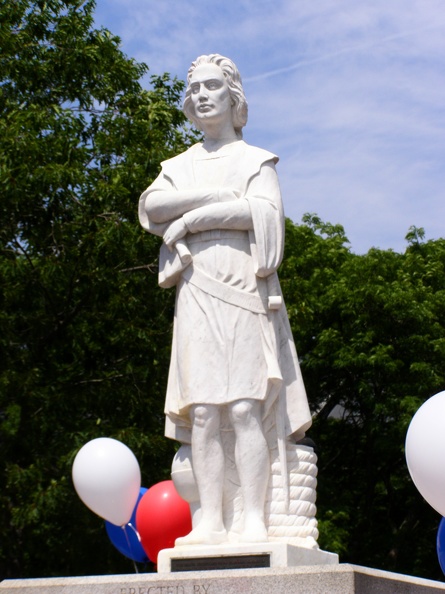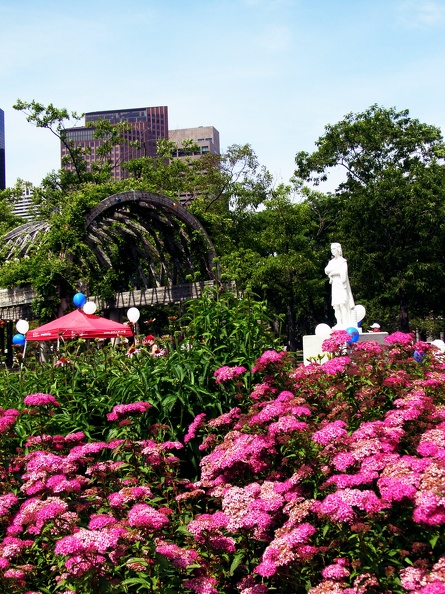On Tuesday, October 13, I attended a virtual meeting of the Boston Art Commission. One of the main topics of discussion at the meeting was the Christopher Columbus statue that was barbarically decapitated in June as part of the Black Lives Matter protests. As anyone who reads my blog can probably tell, that is a topic that I’ve been very interested in and passionate about. I learned some new things at the meeting and got an opportunity to share my views about the Columbus statue.
One thing that I learned is that six works of public art in Boston are currently under review for potential removal, alteration, or addition of interpretive signage. In addition to the Columbus statue and a statue of Abraham Lincoln and a newly freed slave known as the Emancipation Group, the list also includes a statue of military historian Samuel Eliot Morison, the Founder’s Memorial on Boston Common, the Boston Common Tablet, and the Francis Parkman Memorial. The commission already voted unanimously to remove the Emancipation Group because the depiction of the freed slave was deemed to be patronizing. At today’s meeting the commission members discussed logistical details for the removal and storage of that statue. The commission recommends moving the statue to a museum, library, or school, as opposed to a public location. A series of “celebratory” online events involving music and dance are being planned for the days(s) the statue is put into a crate and removed.
Then the meeting turned to the topic of the Columbus statue. The commission announced that they have received reports from two different conservators about repairing the statue. Both reports agreed that the statue’s head could be reattached, but the repairs would be visible. In terms of preventing future vandalism, the reports concluded that there is no practical way to do this. There are no known materials that can strengthen stone to make it more resistant to damage. Putting a longer pin inside the neck to hold the head in place would make it more difficult to decapitate the statue (the idea of someone deliberately attempting to do this is still incomprehensible to me), but even more damage would result if someone (God forbid) did. And the statue could be coated in a material to protect it from paint and graffiti, but this could change its appearance and might need to be routinely reapplied. As a result, the commission recommended not returning the statue to an outdoor public location once it is repaired. This fits with Mayor Marty Walsh’s recent announcement that the statue is too badly damaged to return to its old location, the waterfront park in the North End known as Christopher Columbus Park, and will instead be relocated to an affordable housing development being constructed by the Knights of Columbus.
The commission plans to arrange for the construction of a new sculpture to take the place of the Columbus statue in the park. This sculpture will honor the Italian-American community and its subject will be determined with input from that community. Separately, the commission plans to put up a sculpture honoring the Indigenous community in a different location. “Both of these stories deserve to be told and should not by any means be in competition with one another,” Karin Goodfellow, the city’s Director of Public Art, said at the meeting.
Since the brutal beheading, the statue’s pedestal has been left in place, and the commission recommended keeping it there for now and adding interpretive signage. The pedestal is more than just a base for the statue; it is engraved with names of all the people and organizations who worked to commission it and bring it to Boston.
A variety of views were expressed during the public testimony portion of the meeting:
In the anti-Columbus camp, Jean-Luc Pierite of the North American Indian Center of Boston said that he and his organization oppose the maintenance and public display of any statue of Christopher Columbus and proceeded to list a litany of atrocities – mass rapes, drownings, hangings, hunting by dogs, smashing of infants’ heads against rocks – allegedly committed by the Genoese explorer and his associates. “Neither the statue nor the pedestal have any place in the City of Boston,” he said.
Pierre Belanger of Open Systems complained about the “illegitimate placement” of the statue and the “illegitimate renaming” of the park to Christopher Columbus Park in the first place (it had originally been known simply as Waterfront Park). He even ridiculed the names on the pedestal, calling these individuals “so-called sponsors.”
Rev. Joe Rocha began talking about getting rid of all names of slave owners from the City of Boston, including that of historic meeting house and tourist destination Faneuil Hall. The commissioners pointed out that this topic was outside the scope of the meeting, as the Art Commission does not have any input on the names of public spaces, only the art displayed in them.
On the other hand, several people spoke out in defense of Columbus, describing the statue as an important symbol for the Italian-American community and expressing dismay that the act of vandalism and the possibility of future vandalism are essentially being allowed to decide the fate of the statue. Importantly, the idea of commissioning a new statue of Columbus to take the place of the old one was proposed by several speakers, something that I did not realize was a possibility but strongly support.
For example, Diane Modica of the Sons and Daughters of Italy accused the Art Commission of being biased towards anti-Columbus groups and failing to reach out to the Italian-American community. She criticized society’s maligning of Columbus and of Italian-Americans in general. “Our position in society has been erased,” she said
The next speaker, Laurie Stivaletta, is the granddaughter of an Italian immigrant who landed at Ellis Island and settled in Boston, and whose name is on the pedestal of the Columbus statue. “I am greatly disappointed that an act of violence on our city could change the fabric of our lives,” she said. She argued that Columbus, although flawed, was not the villain he has recently been portrayed as. She called his 1492 voyage “one of the most significant impact points in our civilization” and added, “no one since has impacted the Americas in the same way.” And she made the excellent point that because of its location on the waterfront, the park is the perfect location for a statue of the great explorer and navigator.
Harry Johnston, a North End business owner, said that both Bostonians and tourists love the Columbus statue. “You don’t have to be Italian-American to love Christopher Columbus,” he said. “His statue is beautiful, his story is beautiful.” He called whoever vandalized the statue a terrorist and an extortionist and urged the city not to give in, as doing so might encourage the vandal(s) to attack other statues, such as those of George Washington and Sam Adams. He also mentioned the horrific events in Portland in which statues of Abraham Lincoln and Theodore Roosevelt were destroyed. “You don’t negotiate with terrorists,” he said. “What about the diversity of Italian-Americans?”
Nadia DiCarlo said that Columbus symbolizes immigration and the idea of cultures colliding, and that relocating the statue to a location inside a building would simply not be the same. “Not all historical figures were perfect,” she pointed out.
Commission member Camilo Alvarez called the act of vandalism, although not a good thing, a form of communication. Ekua Holmes, the Vice-Chair of the Art Commission, reassured everyone that no matter what is ultimately decided, the commission does not support brutalizing any work of art.
It heartened me to hear so many people speaking out in defense of the Columbus statue (the pro-Columbus speakers outnumbered the anti-Columbus speakers by about two to one), and it gave me a sense of hope to learn that although far from a certainty, commissioning a new Columbus statue is at least a possibility. The Boston Art Commission meets once a month, and meetings are open to the public. I will likely attend next month’s meeting as well to keep informed of any new developments.




